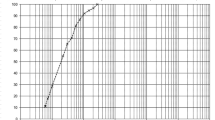Abstract
With rapid advancements in technology globally, the use of plastics such as polyethylene bags, bottles etc. is also increasing. The disposal of thrown away wastes pose a serious challenge since most of the plastic wastes are non-biodegradable and unfit for incineration as they emit harmful gases. Soil stabilization improves the engineering properties of weak soils by controlled compaction or adding stabilizers like cement, lime etc. but these additives also have become expensive in recent years. This paper presents a detailed study on the behavior and use of waste plastic in soil improvement. Experimental investigation on reinforced plastic soil results showed that, plastic can be used as an effective stabilizer so as to encounter waste disposal problem as well as an economical solution for stabilizing weak soils. Plastic reinforced soil behaves like a fiber reinforced soil. This study involves the investigation of the effect of plastic bottle strips on silty sand for which a series of compaction, direct shear and California bearing ratio (CBR) tests have been performed with varying percentages of plastic strips and also with different aspect ratios in terms of size. The results reflect that there is significant increment in maximum dry unit weight, Shear Strength Parameters and CBR value with plastic reinforcement in soil. The quantum of improvement in the soil properties depends on type of soil, plastic content and size of strip. It is observed from the study that, improvement in engineering properties of silty sand is achieved at 0.4% plastic content with strip size of (15 mm × 15 mm).











Similar content being viewed by others
References
Amrutha TP, Krishnan A (2015) An overview on plastic waste as soil stabilizing agent. Int J Adv Res Trends Eng Technol 2(10):36–39
Bhattarai P, Bharat Kumar AVA, Santosh K, Manikanta TC, Tejeswini K (2013) Engineering behavior of soil reinforced with plastic strips. Int J Civ Struct Environ Infrastruct Eng Res Dev 3(2):83–88
Chebet FC, Kalumba D (2014) Laboratory investigation on reusing polyethylene (plastic) bag waste material for soil reinforcement in geotechnical engineering. Civil Eng Urban Plan Int J 1(1):67–82
Choudhary AK, Jha JN, Gill KS (2010) A study on CBR behavior of waste plastic strip reinforced soil. Emir J Eng Res 15(1):51–57
Chouksey SK, Babu SGL (2011) Stress–strain response of plastic waste mixed soil. Waste Manag J 31(3):481–488
Dutta R, Rao GV (2004) Ground improvement with plastic waste. In: Proceeding 5th international conference on ground improvement technique, Kaulalumpur, Malaysia, pp 321–328
Hansen JB (1959) Developing a set of CBR curves. U.S. Army Corps of Engineers, Instruction Report No. 4
IS: 2720-Part 3-1980, Bureau of Indian Standards New Delhi, Feb (1981).Determination of Specific Gravity of Soil Solids
IS: 2720-Part 16-1987, Bureau of Indian Standards New Delhi, May (1988).Laboratory Determination of CBR Value
IS: 2720-Part 5-1985, Bureau of Indian Standards New Delhi, August (1985). Laboratory method for determination of LL and PL of soil
IS: 2720-Part 4-1985, Bureau of Indian Standards New Delhi, January (1986). Laboratory method for Grain Size Analysis
IS: 2720-Part 7-1980, Bureau of Indian Standards New Delhi, December (1980). Laboratory method for Standard Proctor Test
IS: 2720-Part 13-1986, Bureau of Indian Standards New Delhi, May (1987). Laboratory tests procedure for Direct Shear Test
Khabiri Mahammad M (2011) The influence of waste carpet on the structural soil characteristics in pavement granular layer. Int J Publ Thai Soc High Educ Inst Environ 4:38–48
Mercy Joseph P, Haneef FM, Jacob MT, Krishnan R, Rajan S (2014) Effect of plastic granules on the properties of soil. Int J Eng Res Appl 4(4):160–164
Modak PR, Prakash BN, Sanjay DN, Ravindra DN, Vivek SC (2012) Stabilization of black cotton soils using admixtures. Int J Eng Innov Technol 1(5):1–3
Nsaif MH (2013) Behavior of soils strengthened by plastic waste materials. J Eng Dev 17(4):182–194
Vidal H (1969) The principle of reinforced earth. Highway Res Rec 282:1–16
Times of India, article on April 30, 2015 http://timesofindia.indiatimes.com/home/environment/pollution/60-cities-generate-over-15000-tonnes-of-plastic-waste-per-day/articleshow/47110633.cms
Author information
Authors and Affiliations
Corresponding author
Rights and permissions
About this article
Cite this article
Peddaiah, S., Burman, A. & Sreedeep, S. Experimental Study on Effect of Waste Plastic Bottle Strips in Soil Improvement. Geotech Geol Eng 36, 2907–2920 (2018). https://doi.org/10.1007/s10706-018-0512-0
Received:
Accepted:
Published:
Issue Date:
DOI: https://doi.org/10.1007/s10706-018-0512-0




